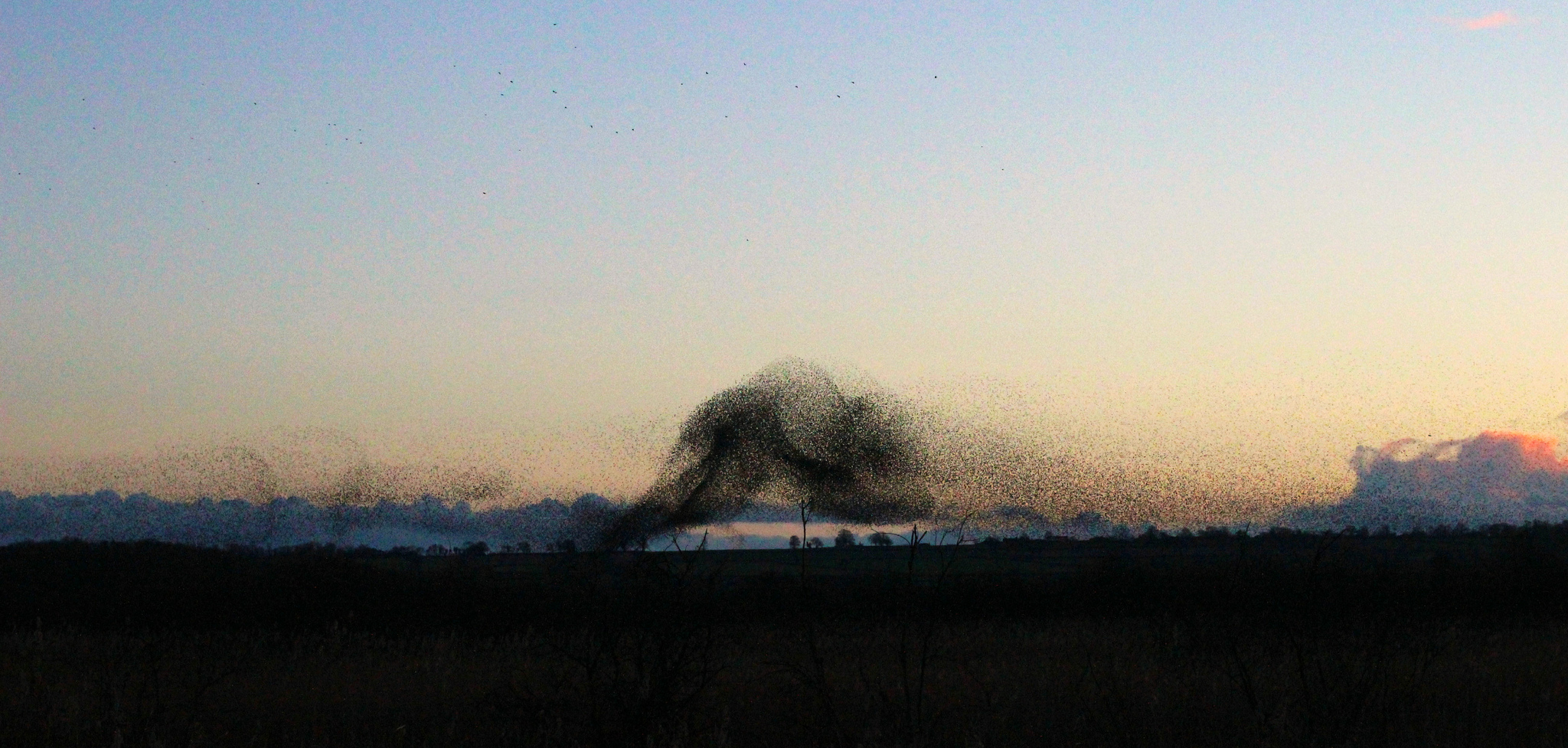A huge mass of black sweeps across the sky; surging, swirling and constantly changing form. This is a murmuration of starlings, an extraordinary natural phenomenon seen in the autumn and winter months.
Such spectacular sights used to be more common when the birds flocked in greater numbers – in 1799, the poet Samuel Taylor Coleridge gave this eye-witness account of a journey from the Lake District to London, as dawn rose over the wintry fields:
“Starlings on a vast flight drove along like smoke, mist, or any thing misty without volition – now a circular area inclined in an Arc – now a Globe – now from complete Orb into an Elipse and Oblong – now a balloon with the car suspended, now a concaved Semicircle – and still it expands and condenses, some moments glimmering and shivering, dim and shadowy, now thickening, deepening and blackening!”
A murmuration can number from 100 to 60,000 starlings, and according to Dr Anne Goodenough of the University of Gloucestershire, the shifting patterns are an important feature. “One of the theories is that it’s a way of avoiding predators, “ she says. “It’s hard for a raptor, like a peregrine falcon or an owl, to focus on one bird when they’re all wheeling and dancing through the sky.”
In the animal kingdom, there is safety in numbers. Sadly, starling numbers have dropped sharply in the past few years.
In the animal kingdom, there is safety in numbers. Sadly, starling numbers have dropped sharply in the past few years, and the UK population has fallen by two thirds since the mid 1970s. The cause of their decline is a mystery, but as a result, starlings are now a protected species in England and Wales under the Wildlife and Conservation Act 1981.
The biology of murmurations remains little studied, but a joint survey, conducted by Dr Goodenough’s team, in collaboration with the Society of Biology, has now been set up to gather data from around the UK. During the 2014-15 starling season, the team received reports of 1,644 sightings The data is being analysed to find out how location, weather, sunset time, and season affect the size, frequency and time of murmurations.
Given that folklore is often inspired by the wonders of the natural world, when people of centuries past looked up at the skies and saw this remarkable force of nature, how might they have interpreted what they saw, and what kind of stories would they have told?
Black is the colour of darkness and mystery, the unseen and unknown. A bird in flight can represent the connection between the physical (body) and the spiritual (airborne). Large black birds, especially crows and ravens, were associated with witchcraft as familiars, a witch’s pet.
The more elaborate murmuration patterns form swirls, peaks and troughs: it doesn’t take much of a leap of imagination to see how a flock of birds stretching out along the horizon at dusk could look rather like a broom sweeping across the sky, leading to tales of witches riding on broomsticks. Some of the cone-shaped swirls (such as those captured by photographer Owen Humphreys) even look rather like a witch’s hat.
Murmurations often take place at dusk, the half-way mark between light and dark, a twilight world where colours fade to grey.
When this surging movement is accompanied by the squawk of birds in surround-sound, it could be likened to the cackle of a witch, or the chuckle of a mischievous sprite. The effect verges on the supernatural – and could possibly be interpreted that way, especially if superstitious folk were to see such a spectacle in the countryside around Halloween, a time when tradition has it that spirits are most likely to appear.
The murmurations often take place at dusk, the half-way mark between light and dark, a twilight world where colours fade to grey, providing an atmospheric backdrop as the birds take flight. But starlings choose this time with a practical purpose in mind. As the sun sets, animal activity peaks, and the birds go in search of their night-time shelter, making the most of the final glimmers of light in the short winter days.
Sometimes, the murmurations appear to form the shape of a large bird: this could be put down to the human tendency to perceive patterns in everything, but coincidental or not, it may have a practical purpose. What better way to baffle possible predators, than to form the image of a larger, scarier creature shape-shifting across the sky?
The saying “birds of a feather flock together” describes a simple survival instinct – but when the starlings display their specialist skills of co-ordination and misdirection, the effect is almost magical.
Image credit: Laura Thorne

